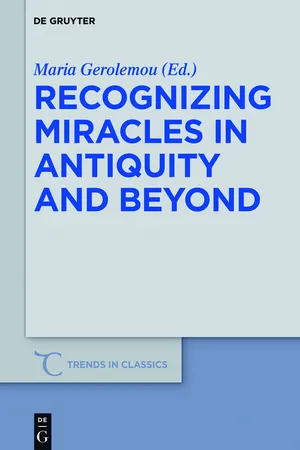In search of Archaic wonder: methodological issues
When confronted with the notion of wonder in Greek literature, we are faced with methodological issues which may be categorized as three. First, there is the gap between real experience and literary representation, which prevents us directly accessing a history of mentalities and historical attitudes toward wonder behind these literary texts. As the medieval historian Carolyne W. Bynum wrote: “Finding wonder-words is easy; finding wonder is far more complicated.”763 Each literary work or corpus of texts develops a representation of the wonderful according to the demands of its own poetics. This literary filter ultimately distances us from ancient experience of wonder, when attempting to grasp historical beliefs and Archaic Greek attitudes toward the marvelous, or track changing attitudes toward wonders, or ponder evidence for ‘real’ individual experience of marveling in Archaic Greece. Conversely, what we the modern readers perceive as wonders are not necessarily characterised as such in the text.
Secondly, an investigation of wonder in Archaic Greek, when based on the occurrences of one of these ‘wonder-words’ (θαῦμα and its derivatives), confirms the broad assumption that conceptual distinctions in Ancient and contemporary languages do not necessarily overlap.764 When dealing with θαῦμα-words, we are first and foremost confronted with a discrepancy between our modern conception and the ancient: the division of conceptual fields does not correspond to ours. Θαῦμα subsumes a certain number of categories, which modern languages distinguish: wonder, admiration, amazement, perplexity, astonishment, etc., and these nuances do not exhaust all aspects of a word which signifies primarily an experience of the extraordinary. These emotional reactions align themselves between two extremes, the one euphoric, the encounter with the object of a desire, and the other dysphoric, when the extraordinary phenomenon thwarts the expectations of the subject, and when surprise borders on the sentiment of revolt and scandal. The wonder-reaction in Archaic poetry ranges from fear, anger or indignation, to admiration, hermeneutic astonishment or true delight.
However, the mingling of emotions which are distinguished in modern language is not the only difficulty the concept presents, as it is a concept without a fixed field of reference. The third issue concerns the nebulousness of this essentially protean notion. For the referential extension of θαῦμα is infinite. This concept lacks an essential property, that of being delimited within a determined field – to quote Pindar, θαύματα πολλά “wonders are many” (Olympian Odes I.28). There are no fixed categories of θαύματα: we find in texts a multiplicity of spectacles equally considered θαύματα, yet as diverse as the splendid chariot of Hera (Iliad 5.725), the monster Typhoeus (Theogony 834), a paradox (Odyssey 4.655), or a thousand other phenomena touched with a startling or marvelous quality. In this diversity of spectacles apt to provoke wonder, one can identify what could be called ‘collections’, ‘series’ (and also ‘repositories’) of θαύματα affected with recurring qualities – accessory and contingent characters conducive to a cartography of wonderful phenomena. Works of art, special artifacts such as automata, distinctive human beings, hybrids, monsters, giants, phenomena such as apparitions and disappearances, petrifactions, and metamorphoses may constitute some samples of these series, with their own ‘ingredients’ or recurring qualities (to use the expression of Richard Neer: ‘key ingredients of Greek wonder’).765 However, this catalogue or ‘cartography’ of marvels constitutes an unstable ensemble, always open to variation between authors and works.
Despite the protean nature of the concept one can still say that in most Archaic occurrences of the word, θαῦμα is something seen and inherent in sensory appearances. The gaze which it provokes implies a particular modality of visual perception, that I will try to show in the first part of this paper. Then I will expound two opposite facets of wonder in the Homeric and Hesiodic corpus. Whereas some descriptions of wonder-reaction stage a θαῦμα unburdened by suspicion, other instances develop a tendency to warn against a θαῦμα clearly disclosed as deceitfulness, ἀπάτη or δόλος. Now, this negative or positive value of θαῦμα seems to be closely linked to the status of sight.
Θαυμάζειν: a modality of looking
The word θαῦμα in Ancient Greek blurs the distinction between subject and object as it applies both to the feeling experienced by the subject and to the object which excites the feeling – as in English ‘wonder’, but not as in French, where two different words are used, ‘merveille’ for the thing, and ‘émerveillement’ for the emotional reaction (‘wonderment’). But the substantive θαῦμα in Archaic Greek epic rarely refers to the feeling of wonder – and never in the Iliad.766
What is designated as θαῦμα is first and foremost defined as spectacle:767 in Homer, especially in the Iliad, the astonishing and the marvelous are essentially there to be seen, whether it is a spectacle which a character says he has seen (ὢ πόποι ἦ μέγα θαῦμα τόδ᾿ ὀφθαλμοῖσιν ὁρῶμαι)768 or an object which the narrator or one of the characters presents as a marvel to be seen: θαῦμα ἰδέσθαι.769 The verb θαυμάζω is usually accompanied by a verb denoting visual perception in a circumstantial clause, a relative clause or in the form of an circumstancial participle...


